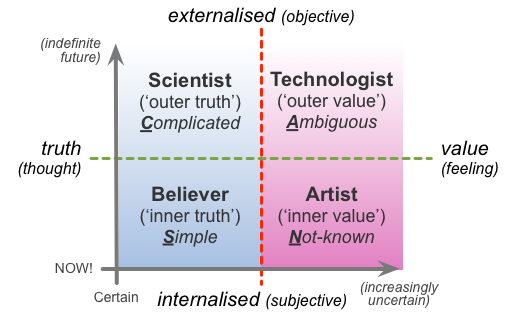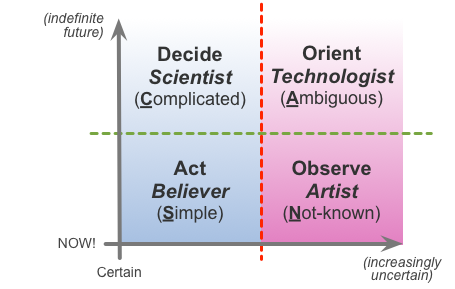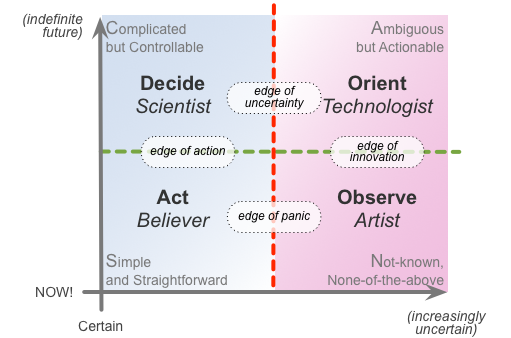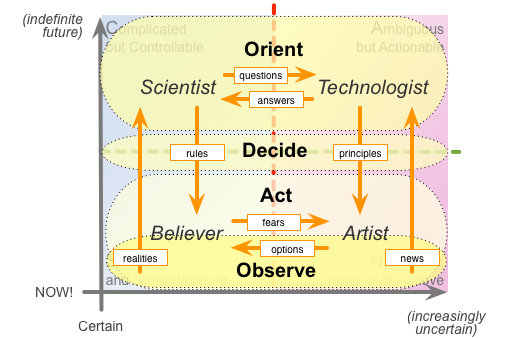Seven sins, sensemaking and OODA
Following from that recent series on sensemaking and ‘Seven sins of dubious discipline‘, it seems worthwhile to look at that whole context-space from a different direction, another example of a proven metaframework for much the same kind of metadiscipline – namely John Boyd’s ‘OODA-loop‘, ‘Observe, Orient, Decide, Act’:
On the surface – and how many people still interpret the OODA model – it seems to be a simple step-by-step loop. For our purposes here, in this series, we could reframe ‘Observe’ as ‘sense‘ – the process of sensing out what seems to be happening in our world – and ‘Orient’ as ‘make-sense‘ – literally ‘sensemaking’ from what we’ve observed – which leads us onward to decide and act, at which point we loop back to sense and make-sense again.
So if we take that set of disciplines for sensemaking and decision-making from the ‘swamp-metaphor‘ – the set that we’d used throughout the ‘Seven sins’ series:
Which in turn we’d also cross-mapped to the SCAN framework for sensemaking and decision-making:
Given all of that, then at first glance all of those sensemaking-disciplines – Scientist-mode, Believer-mode, Artist-mode, Technologist-mode – would seem to fit naturally into the ‘Orient’ phase of the OODA-loop. Or perhaps, more accurately, each of those disciplines or modes provide us with approaches and methods that we use within the Orient phase for ‘analyses and synthesis’, to work on those themes listed in the OODA model: new information, previous experience, genetic-heritage, cultural tradition and more.
Which tells us that if any of the ‘sins’ are in play, we’re going to get screwed-up decision-making, followed by screwed-up action, followed by sensing that in turn is probably pre-filtered by Gooch’s Paradox – “things not only have to be seen to be believed, but also believed to be seen” – which will drive even less-realistic sensemaking, further feeding the same ‘sins’ that started the mess in the first place. Otherwise known as Not A Good Idea…
Which is problematic in itself.
Yet it also misses a fundamental point: the OODA ‘loop’ isn’t a linear loop – it’s fractal, recursive, re-entrant, looping through itself at multiple levels all at the same time. There’s sensemaking within action, action within sensemaking, decisions affecting how we sense and observe. It’s fractal.
And once we get to that point, we can do some further cross-maps between OODA and the disciplines-set that clarify more how those loops actually work, and how and why the ‘sins’ are so problematic.
(Please bear in mind that what follows is somewhat work-in-progress: as with all crossmaps for context-space mapping, its aim is to trigger new ideas and understandings, not purport to be ‘The Truth’!)
First, we can crossmap OODA, the swamp-metaphor disciplines and the SCAN sensemaking-domains as follows:
Which, among things, suggests the Orient phase is about exploring or working-through all of the ambiguities of what’s observed in real-time action. It also warns that that part of the OODA-loop necessarily happens away from real-time – hence why speed of processing here, and in the Decide phase, become critical within anything that needs to happen at or near real-time.
And when we compare that crossmap above, and what we’ve explored in the previous posts in this series, back to the original OODA diagram:
…that comparison also illustrates a bit more about what happens in the ‘feedback’ and ‘implicit guidance’ paths shown on the OODA diagram:
- unfolding interaction, Act to Observe – unfiltered ‘reality’
- feedback, Act to Observe – action changes the context, feeding wicked-problem effects
- feedback, Decide to Observe – decisions filter the observation, feeding echo-chamber risks
- implicit guidance, Orient to Observe – assumptions and expectations filter the observation, likewise leading to echo-chamber risks
- implicit guidance, Orient to Act – assumptions and expectations from prepackaged ‘solutions’, bypass the decision-making process, leading to ‘solutioneering’ and inability to adapt to context
Another useful crossmap invites us to explore implications of the ‘edges’ between the SCAN-domains:
…via which, when we remember that all of this fractal, actually points toward a somewhat different mapping, oriented more around time and the ‘NOW!’ of action:
The first of those two crossmaps implies a kind of counterclockwise rotation, from Artist to Believer, mirroring the classic idea → hypothesis → theory → law → new-idea loop for scientific-development. The other implies a more straightforward up-and-down path, linking back-and-forth between Believer and Scientist, and between Artist and Technologist modes, driven primarily by an action ↔ reflection cycle. In that sense, they do look very different – in fact are very different.
And yet both of these crossmaps are also ‘true’ – for a given value of ‘true’, anyway – in the sense that both crossmaps do describe key aspects of what’s actually going on in the ‘OODA loop’.
The point here is that this strange kind of merging-together of same-and-different gives us some crucial clues not only about OODA, but about context-space mapping in general, with frameworks such as SCAN used as the respective base-maps for crossmap comparisons.
First, on OODA itself. What we’re seeing here is the OODA is not just a simple loop – it’s describing something that’s much more complex, as Boyd’s diagram does imply, and that many people still seem to miss. Yet it’s actually richer again than Boyd portrays – for example, there are different disciplines and more that are involved on either side of the ‘edge-of-uncertainty’:
- OODA Observe: structured Believer versus Artist unstructured/open observation
- OODA Orient phase: Scientist for the more-predictable side, Technologist for the less-predictable or more-unique
- OODA Decide: tame-problem algorithms versus wild-problem guidelines
- OODA Act: tame-problem rules versus wild-problem principles (as the respective drivers passed to ‘Act’ for guidance within real-time action)
Ideally, Observe would always be the Artist, in its purest possible form. But reality just doesn’t work that way: there’s always some cognitive-bias, some element of prefiltering that comes from the Believer, if only to reduce the risk of drowning in the real-time flood of sensory impressions.
And there’s also the recursion, the fractality, not just in the two SCAN axes, but of the OODA-‘loop’ as well. That’s what we see particularly in those two horizontal exchanges, between Scientist and Technologist, and between Believer and Artist, that would otherwise not really happen if OODA was merely a simple linear loop.
From here, using either of those two OODA/SCAN crossmaps above, we can then do further crossmaps with each of the ‘seven sins of dubious discipline‘, to explore how each respective ‘sin’ acts on the OODA-loop – or rather, how each ‘sin’ disrupts different aspects of the natural flow of that loop.
(I’ll cheat at this point, and leave the diagrams for those ‘sins of OODA’ crossmaps as ‘an exercise for the reader’! – they’re all straightforward enough, as you’ll see if you sketch them out yourself.)
The other focus here is what this tells us about context-space mapping. Remember that context-space mapping is, literally, a way of mapping out a context-space to make sense of what’s going on in that context. In practice:
- we select any appropriate framework – for example, SCAN or SCORE or Enterprise Canvas – to use as a base-map via which to elicit insights about the context
- optionally, we overlay other frameworks – for example, Causal Layered Analysis or, as here, OODA – to provide crossmaps with the initial base-map
The base-map is always just a view into the context: to paraphrase the classic quote from George Box, it’s always incomplete, always ‘wrong’, but potentially-useful. And in a crossmap, often what we’re looking for is places where the frameworks do not agree, where there’s mismatch rather than match, or where gaps are implied by misalignment between the frameworks.
In a sense, in context-space mapping we turn the whole ‘frameworks’ idea back-to-front. Rather than the usual approach of purporting that the respective framework is ‘the truth’, to which the real-world would or ‘should’ always conform, we say instead that the real-world is always itself – nothing more, but also nothing less. We then use each framework’s often-arbitrary dimensions, assertions and assumptions to filter our view of that context, to provide us with some kind of structure through which to start to make sense of that context. We acknowledge, right from the start, that a single framework can never show us more than a subset of that unified ‘oneness’ of the context itself. Yet by overlaying frameworks onto the context, as crossmaps, we build a picture from multiple directions that’s made up of interweaving, interleaving subsets, supersets and intersecting-sets – a picture that can be much richer, and elicit more insights, than it would otherwise have been with just a single framework.
In effect, context-space mapping is just one way, one technique, one type of discipline, for the back-and-forth sensemaking-loop between OODA’s Observe and Orient. Within which loop, recursively, we might use OODA itself – and, in turn, that back-and-forth is also part of OODA. What we do with those insights, within OODA’s Decide and Act, is another question, of course… – yet also the whole point of it in practice!
Anyway, let’s leave it at that for now: I hope it’s useful to someone – and over to you for comments and suchlike, as usual.






Just a quick conceptual link to Steve Haeckel’s renaming of the loop as Sense, Interpret, Decide, Act (SIDA), which some of us are inclined to fall back on, though OODA existed well before.
Many thanks, Doug.
I’ve been using the structure ‘Sense, Make-sense, Decide, Act’ because it aligns well with that common concept of sensemaking and decision-making. But you’re right, ‘Interpret’ is perhaps a better way to describe it than ‘Make-sense’ – and the acronym ‘SIDA’ is easier to say/use than ‘SMDA’, too. 🙂
While we’re on the OODA loop and variations, I happened to come across a reference to Deming and his PDCA loop: https://www.researchgate.net/publication/281297714_Theory_of_profound_Knowledge_by_Deming
The interesting thing there is the apparent inward focus of PDCA, vs. the other formulations that are clearly focused on sense-making wrt a wide context
Again, thanks, Doug. Good point about “the apparent inward focus of PDCA”, versus the much broader awareness that’s needed for the kind of sensemaking we do in enterprise-architecture and the like.
Sensemaking or Tom G’s “make-sense” is in my opinion a better term in this context than “Interpret” and fits a Weickian exposition of sensemaking. I am in agreement that OODA its not a linear process. Using “Interpretation” in my view impoverishes the notion of “Orient”. Sensemaking encompasses interpretation, authoring, creation and importantly – discovery. Its not just about “”interpretation”.